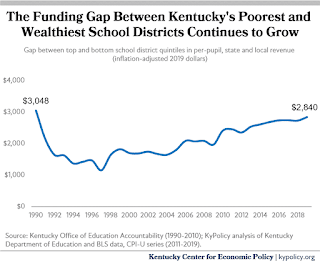Kentucky's "Education First" Budget
Exactly a year ago, Governor Beshear and members of the General Assembly were beginning the work on what was billed as an "education first" budget. Unfortunately, the pandemic interfered with the budget process and Kentucky-- like all other states-- went into fiscal survival mode.
Flash forward one year, the Governor and legislature have an opportunity-- despite the continuation of the pandemic-- to move forward with a budget that focuses on adequate funding of public schools. While both the Governor and Republican controlled legislature will be touting education as a priority in this budget session, it is worth closely examining what an "education first" budget really means.To really understand, we need to explore the debate about the idea that money really matters in education. One of the most deceptive strategies of education reform over the past 20 years has been to sow doubt about the importance of school funding. The approach has been advocated by those that either do not want to increase the financial investment in public education as well as those who say the public schools are inefficient or ineffective and a new approach is needed rather than more money. To sow this doubt, they sold an outcomes based approach--using high-stakes standardized tests as evidence that public schools are failing. This has been an effective mirage to bring the focus away from inputs and redirect efforts away from increased funding for schools. I plan to address the research that debunks this approach in a subsequent post, but for now, it is important to admit that money matters in education and that our public schools are not adequately funded.
The problem is even more acute for schools that serve the most disadvantaged and the most diverse of our students. The following excerpt from the Kentucky Center for Economic Policy blog is a good illustration of this challenge and how much ground we have lost in the Commonwealth over the past decade:
"Funding for local schools through the SEEK (Support Education Excellence in Kentucky) formula remained stagnant in the 2021 budget, which means that when compared to 2008 funding levels, the state is spending 16.2 percent less per student when inflation is taken into account, as shown in the graph below. Kentucky was already 4th-worst among states for per-pupil cuts in core funding since 2008.These per-student, inflation-adjusted cuts have caused districts to make reductions to staff, course offerings, school-based services and more.""Without additional state funding for SEEK in 2021, the funding gap between Kentucky’s poorest and wealthiest school districts continues to grow. These inequities are almost as pronounced as they were prior to the 1990 passage of the Kentucky Education Reform Act (KERA), which addressed the state’s unconstitutionally inequitable school funding by creating SEEK. The SEEK formula is designed to distribute funding in an equitable way by providing more state funds to poorer districts that are less able to raise local dollars with equivalent effort due to lower property tax bases, and setting an upper limit on the amount wealthier districts can raise to prevent the gap from growing too large. However, because the amount the state contributes under the formula has not been sufficient, local districts have needed to raise more revenues, and with wealthier districts having more capacity to do so, that gap has widened significantly. As a result, wealthy districts had $2,840 more in state and local revenue per student than poor districts in the 2019 school year (the most recent for which data is available). The gap increased $122 in 2019 compared to the prior year, and is now just $208 shy of the pre-KERA gap in inflation-adjusted terms."
So what is educational adequacy?
Several advocacy organizations in the Commonwealth, including the two that I affiliate with, the superintendent's association (KASS) and the school administrators association (KASA), quantify adequacy in their legislative priorities. They advocate increased funding that supports SEEK, instructional resources, exceptional children, family and youth service centers, school safety, professional development, and support for the most disadvantaged students. All valid and significant issues when trying to restore previous cuts and avoid falling further behind in the pandemic recession.
But it does not take a deep exploration of school district budgets to see that a vast majority--between 80 and 90 percent-- of funds include salaries for the educators that work in our schools. Adequate funding enables districts to attract the best people to work in education. Money matters because the quality of people that work with our students matters. The research is clear. Study after study have demonstrated that teachers matter more to student achievement than any other policy approach of schooling. Remaining competitive means attracting and developing the highest quality teachers and staff. The only way to do that is admit money matters and adequately fund public schools.


Comments
Post a Comment